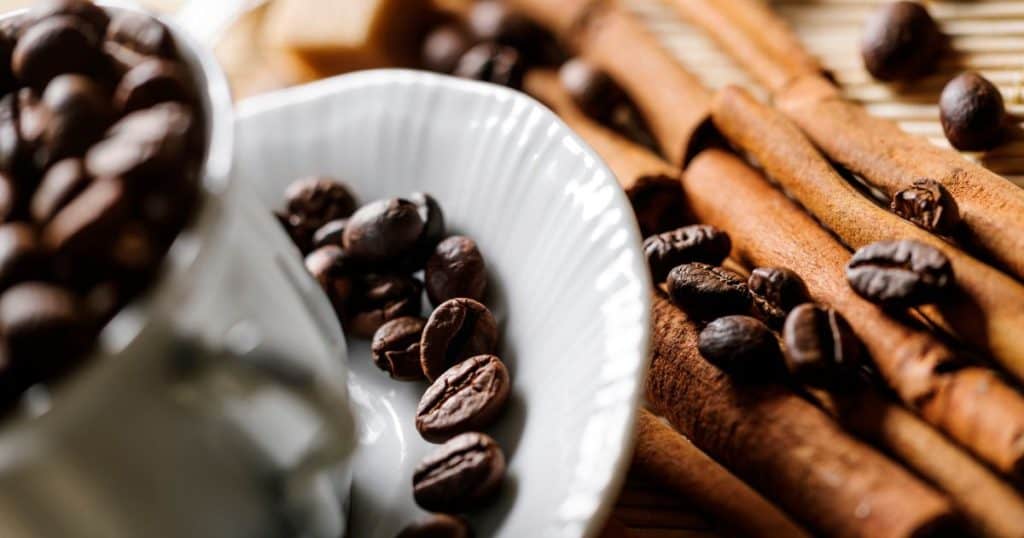So, is coffee basic or acidic? We all know that coffee is a popular beverage consumed all around the world, with some variations depending on culture. However, both darker and lighter roasted coffees have one thing in common – acidity at various levels.
Acidity levels vary significantly based on the roast; generally speaking, acidity is higher in lighter roasts and lower in dark roasted coffee. But can the acidity levels of coffee be reduced even further?
How acidic is coffee? And could a natural remedy like cinnamon help to reduce acidity in coffee and keep your acid reflux in check? This article will explore the potential benefits of adding cinnamon to coffee drinks, and whether or not it can effectively help lower acid levels.
Read on to find out more!

Cinnamon has been used for centuries as a natural remedy to help with digestive issues, and its potential impact on stomach acidity is particularly of interest.
Recent studies have found that cinnamon may reduce the amount of acid produced in the gut, which could potentially alleviate acid reflux symptoms.
Nonetheless, further research must be conducted before we can definitively say that cinnamon reduces levels of gastric acids.
To this date, the most impressive study conducted on cinnamon’s effects involves a mixture of cardamom, ginger and cinnamon itself. Results from testing it on rats demonstrated that taking the mixture before meals lowered overall acid production levels significantly.
Although these are promising results, medical trials still need to be done in humans to verify its efficacy towards decreasing stomach acids.
Recent research indicates that cinnamon and honey may reduce the amount of stomach acid produced after drinking coffee. A 2015 study found that adding 1 gram of ground cinnamon and 5 milliliters of honey reduced hydrochloric acid levels in the stomach.
Is coffee alkaline or acidic? Coffee is known to be acidic and adding cinnamon could potentially reduce these levels. However, the specifics depend on several factors, like the type of bean, the roast, and the brewing method.
Related Article: Drip Coffee vs Pour Over: Master the Art of Coffee Brewing with Bee House
What is Cinnamon?
Cinnamon is a common spice that comes from the inner bark of cinnamon trees. It has been used for centuries as both a seasoning and for its medicinal properties. Cinnamon sticks are commonly used to flavor coffee, tea and other foods, with cinnamon powder also being used in baked goods.
Cinnamon itself is high in antioxidants, which may help protect cells from damage and help prevent disease. In addition to its antioxidant properties, cinnamon is also known for its effect on reducing the acidity of coffee when added as part of a recipe or drink.
In many cultures, cinnamon is used to reduce acidity in coffee by adding cinnamon directly into the brewing process. This method has been around for centuries, and cinnamon is believed to reduce the acidity of coffee without affecting its flavor.
For example, cinnamon can be added directly into a French Press while brewing coffee. The cinnamon will then steep with the coffee grounds and infuse their flavor as well as reduce acidity levels in the final brew.
Want to geek out more on what Cinnamon is and some history of it? Here is the >>” data-lasso-id=”98″>Wiki page for Cinnamon>>>

Types of Cinnamon
When it comes to types of cinnamon, there are two main varieties you’ll find in stores: ceylon cinnamon and cassia cinnamon.
Ceylon Cinnamon is also known as true cinnamon or the Sri Lankan variety. It has a lighter flavor than cassia, with notes of citrus and spice. Ceylon is also more expensive than cassia and is often the preferred type for baking since it has a sweeter, milder flavor.
Cassia Cinnamon is the more common variety of cinnamon found in supermarkets and is typically used in savory dishes. It has a strong, bitter flavor that can be overpowering when used in large quantities. However, it is the cheaper option and can be used to reduce acidity in coffee.
When using cinnamon for coffee, ceylon is usually the recommended type as cassia can be a bit too overpowering. Ultimately, it’s up to personal preference – so experiment with both types until you find the perfect blend for your morning cup of joe.

Can Cinnamon Reduce Acidity in Coffee?
The short answer is yes, cinnamon can reduce acidity in coffee. Studies have shown that adding ground cinnamon to the brewing process has the potential to reduce hydrochloric acid levels in coffee.
Additionally, using a mixture of cardamom, ginger and cinnamon may even further reduce gastric acid production levels.
When it comes to brewing coffee, small amounts of cinnamon can go a long way. A small pinch of the spice is enough to reduce acidity levels in a morning cup of joe without overwhelming the flavor – making it an ideal addition for those who are looking for a low-acid coffee option.
Ultimately, adding a small amount of cinnamon during the brewing process is the best way to reduce acidity in coffee. The spice has proven its effectiveness in laboratory settings, and more extensive studies are needed to confirm its potential effects on humans.
Nevertheless, it’s worth a try if you’re looking for an easy, low-cost way to make your coffee less acidic without compromising flavor. If anything I find it makes my morning coffee a little sweeter and less bitter.
How to Use Cinnamon for Coffee
Using cinnamon with coffee is a great way to reduce the acidity of coffee and add a bit of flavor. Here are some simple tips for using cinnamon in coffee:
1. Add a pinch of ground cinnamon to your coffee grounds before brewing. Depending on your brewing method, you may want to grind the coffee beans and cinnamon together in a coffee grinder before brewing.
2. Add a 2 inch piece of a cinnamon stick to your French Press or pour-over coffee maker while it’s brewing. This will give the coffee an even more intense flavor, without too much additional acidity.
3. Try adding some cinnamon and honey together for a sweetened black coffee. The honey will balance out the bitterness with added sweetness, while the cinnamon helps to reduce the acidity of your coffee.
4. To make a coffee-infused tea latte, simply steep some cinnamon tea with coffee grounds for a few minutes before straining into a mug and top off with some warm frothed almond milk. This is great for anyone who wants to enjoy coffee without all of the acidity.

Potential Benefits & Side Effects of Adding Cinnamon to Your Coffee
Adding cinnamon to your coffee can have potential health benefits, as well as some side effects.
Potential Benefits:
– Cinnamon may help reduce acidity levels in coffee and balance out the pH scale. This can make coffee easier on the stomach for those who suffer from acid reflux or heartburn.
– Cinnamon can also add a subtle flavor to coffee without causing an overbearing taste.
– Some research suggests cinnamon may help regulate glucose and cholesterol levels, making it a beneficial addition for those looking to monitor their sugar intake.
Side Effects:
– Cinnamon can be overpowering if used in excess, so it’s important to use it with caution.
– If you’re looking to decrease acidity levels in coffee, too much cinnamon can have the opposite effect and make coffee less palatable.
– Consumption of large amounts of cinnamon may cause gastrointestinal issues such as nausea, cramping or bloating.
Overall, adding a small amount of cinnamon to coffee may offer some health benefits, but it’s important to use caution and avoid adding too much. If you’re new to using cinnamon in coffee, start with a small pinch and adjust as needed.
It’s also wise to consult with your doctor if you’re concerned about any potential side effects before consuming large amounts of cinnamon.
Looking for a coffee alternative thats loaded with healthy benefits? This article on the benefits of drinking Date Seed coffee is what you need>>>
Brewing Methods for Lower Acidity
Many brewing methods can be used to reduce the acidity in your coffee. Here are some of the best ways to get a low-acidity cup of joe:
1. Cold Brew Coffee – Cold brew coffee is made by steeping coarsely ground beans in cold water for 12-24 hours, resulting in a less acidic, less bitter cup of coffee.
2. French Press – Using a french press to brew your coffee can reduce acidity levels due to its slower brewing process and paper filters which trap more oils and acids than metal filters.
3. Drip Coffee Maker – Drip coffee makers typically produce lower acidity coffees as the water is heated to a lower temperature for a longer period of time.
4. Turkish Coffee – Turkish coffee uses very finely ground beans which are boiled with water and served thick and creamy, making it one of the least acidic brewing methods available.
5. Coffee-Infused Tea Latte – Adding tea leaves to your coffee can help reduce its acidity, making it a great choice for those with sensitive stomachs.
If you’re looking to lower the acidity in your cup of joe, experimenting with different brewing methods is a great place to start.
With some trial and error, you’ll soon be sipping on the perfect low-acidity cup of coffee.
Read more on different styles of brewing coffee here>>>

what else besides cinnamon can I add to lower acidity?
If you’re looking for alternatives to cinnamon for reducing acidity levels in coffee, there are a few other ingredients that may also do the trick.
1. Baking Soda – Adding a teaspoon of baking soda(sodium bicarbonate) to your coffee can help neutralize the acidity, resulting in a smoother flavor profile.
2. Salt – A pinch of salt can help tone down the bitterness of coffee while also reducing its acidity.
3. Honey – Adding a teaspoon of honey to your cup of joe can help balance out the flavor, making it slightly sweeter and less acidic.
4. Milk or Cream – Adding dairy products to your coffee can help reduce acidity and mellow out the flavor.
5. Egg Shells – Believe it or not, crushing up egg shells and adding them to your coffee grounds before brewing can help reduce the acidity in your cup of joe.
6. Low Acid Beans – If you’re looking for a permanent solution to your coffee’s acidity, opt for beans that are specifically labeled as “low acid”. These beans have been specially treated to reduce the levels of acidity.
Finally, if you’re looking to reduce acidity without adding any additional flavors or ingredients, you can also try a pour-over or slow-drip method of brewing. These methods require a slower extraction process, resulting in lower levels of acidity.
Ultimately, there are plenty of ways to reduce the acidity in your cup of coffee, so experiment with different methods and ingredients until you find what works best for you! Good luck!

Final Thoughts on Using Cinnamon in Coffee
When it comes to using cinnamon in coffee, the key is finding the right balance that suits your tastes. A small pinch or two of ground cinnamon can add a nice flavor and aroma to your morning cup of joe, as well as offer potential health benefits.
Just remember to use caution when adding additional ingredients and always consult with your doctor if you are concerned about any potential health risks associated with consuming cinnamon.
Cinnamon isn’t the only way to reduce acidity in coffee, and experimenting with different brewing methods and ingredients can help you find the perfect cup of low-acid coffee.
So, Can Cinnamon Help Lower Acid Levels in Coffee?
To wrap this up, cinnamon is an aromatic and flavorful spice with a wide range of culinary uses. There are two main varieties of cinnamon – Ceylon and Cassia – both of which offer different flavor profiles and health benefits. Adding a small pinch or two to your morning cup of coffee can help reduce its acidity levels, resulting in a smoother cup of joe.
Plus, there are potential health benefits to be gained from adding cinnamon to coffee, including reduced inflammation and free radical damage.
However, it’s important to use caution when adding additional ingredients and always consult with your doctor if you have any concerns regarding potential health risks associated with consuming cinnamon.
If you’re looking for a more permanent solution to reducing the acidity in your cup of coffee, there are plenty of other ingredients and brewing methods you can try – from baking soda to low-acid coffee beans to coffee alternatives.
Frequently Asked Questions
Can Coffee Change your PH Balance?
It can! The added acid can impact your bodies natural PH levels, especially if your coffee consumption is as high as me. If this is something you are concerned with I would suggest you talk with your doctor for actual medical advice.
Is Caffeine Acidic?
How acidic is coffee? Believe it or not caffeine is actually an alkaloid. Meaning, No it is not acidic. So its not the caffeine thats throwing your stomach off… its the hot coffee itself. Drink cold brew for higher caffeine and less of the coffee acidity you are familiar with. Don’t give up being the coffee lover you are, go for the cold brew brewing method.
